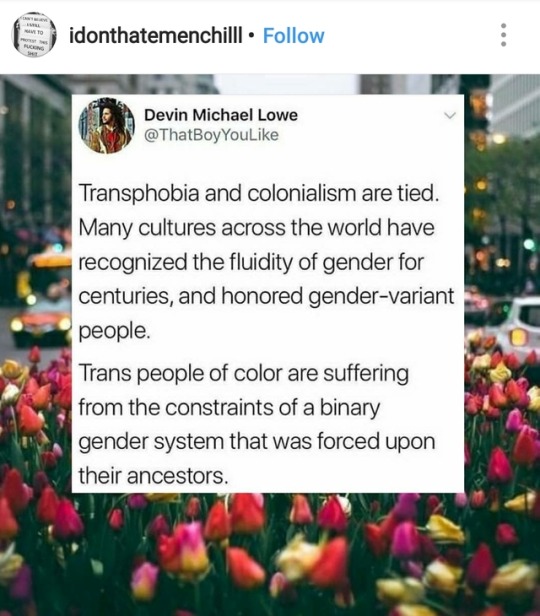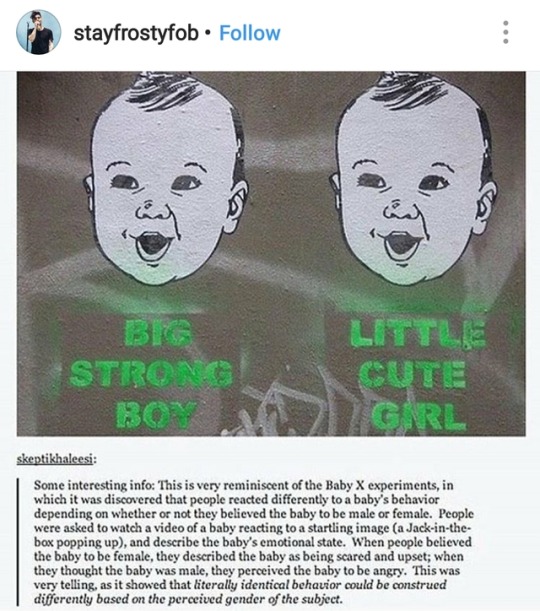Text
Scrapbook Analysis
This scrapbook project serves as a way to summarize the Gender studies class by taking four “artifacts” from each chapter discussed in class and relating them to those chapters. When searching for my artifacts I tried to relate them to pop culture and this generation. A lot of my artifacts come from other posts on social media sites, including Instagram and Twitter. I also had artifacts about well-known social media influencers that many people would recognize, as well as a character from a well-known TV franchise. I also made sure to include artifacts that I found entertaining, and not too many long articles that may seem boring.
Part II
When making my scrapbook, I decided to keep things in order. The first part I posted was ideas. In this section I posted a video called “Sexist Toys” the video was uploaded by Rachel Ballinger who is the person talking. She made this video because she saw Target was selling a selfie kit that was “for girls only”. This sparks some anger inside her and she discusses other harmful stereotypes in toys. I put this under ideas because it touches on what we stereotypically believe is “for boys” and “for girls”. The next thing I posted is an article about a genderfluid Character on the Netflix show Degrassi. The “Ideas” chapter touches on the binary and the character, Yael, feels as though they do not fit in the binary, they don't feel like a boy or girl. The article provides basic information about the particular episode where Yael comes out, without spoiling. My next post is a video of Youtuber, Gigi Gorgeous, coming out as transgender. The video was uploaded a few years ago and Gigi has recently made a documentary showing her process. I would definitely recommend the documentary to anyone who is still confused about what being transgender means, so I included a link to the trailer in the caption of my post. My last post for the Ideas section is an Instagram post by the account “greenboxshop”. The image shows someone wearing a shirt that says, “gender is a social construct”. The owner of the account also owns a clothing business with shirts like this one. The Ideas chapter mentions the idea of gender being a social construct, which this shirt claims to be true.
Part VI
The next section I have in my scrapbook is inequalities, and my first post is an Instagram post, from “soft.feminism”, of a screenshot from Twitter. User @MrLawson posted a picture of a list of things 4th-grade boys don't like about being boys. The chapter discusses inequalities that men and women both face including some of the things on the list. The next post is a video about school dress codes. The woman in the video interviews female students at a high school in Kentucky who are fighting the dress code which has very specific measurements for the skirt and short lengths. The video not only talks about the inequalities for these young women, but it also touches on how it impacts the male students as well, saying they often feel insulted by the rules. The next thing is an article that suggests that men use sexist and homophobic jokes because they are insecure about their own masculinity. The chapter talks about men avoiding feminine things in order to boost their masculinity, this may involve putting femininity down. The last item in this section is a video of fathers reacting to their daughters getting catcalled. Catcalling is a common example of an inequality women face. Usually, men are not aware of how serious and scary this experience is unless they witness it happening to loved ones. In this video, it's obvious that they care that it is happening to their daughters but, is that the only way we can get them to understand?
Part III
The next section on my scrapbook is bodies, starting with a short video about the nature vs nurture debate which was discussed in the chapter. The next item is another video that talks about the nature vs nurture debate, but this one goes more in depth and provides claims and evidence for both sides. It also questions whether gender is a social construct or not. The next artifact is an Instagram post from “stayfrostyfob” of a screenshot of a Tumblr post. The image shows two identical babies, one is a “big, strong, boy” and the other is a “little, cute, girl”. The description basically says that there have been experiments where people reacted differently to a babies behavior based on whether they thought it was a boy or girl. When babies cried, for example, people described the “male” babies as being angry and the “female” babies as being scared. The last thing in this section is a video called, “are boys smarter than girls?” it provides information about the differences between the sexes.
Part IV
Next, I moved on to performances starting with a TED talk with a teacher talking about how her kindergarten students taught her about gender. She begins by talking about a student she had in the past named Michael who was extremely shy. She then explains how she bumped into that student who now identifies as female and goes by Mandy. This inspired her to ask her kindergarten students to list the differences between boys and girls. And they, herself included, learned that there weren't many significant differences. The artifact is a video of a guy listing five times schools tried to enforce gender roles. One school made a boy remove his makeup because it was “distracting”. And another school kicked a girl out of prom because she wore jeans. They claimed it went against the dress code, that did not exist. The performances chapter talks about gender rules and when breaking the rules is acceptable. For these students, it was not acceptable for them to break the rules, and for these schools, gender rules and roles are important to maintain. I then posted another video, this one talking about gendered marketing. It points out how companies can sell the same product to men and women by simply changing the packaging, and many other ways they do it. The last thing is something I feel sums up performances, and how silly gender roles actually are, is a drawing of a little boy dressed as Elsa, and a little girl dressed as Spiderman. The writing on the drawing says, “It’s okay for girls to be Spiderman, and it’s okay for boys to be Elsa”. The Instagram account, “activistbitches” posted this image, however, I am not sure if they are the original artist. The image really questions society’s reasoning for specific gender rules.
Part V
I posted artifacts that related to the Intersections chapter, and to start it off I reposted a simple image reading, “Your feminism isn’t feminism unless it’s intersectional”. This was posted by the Instagram account, “idonthatemenchill”. A lot of people who claim to be feminists only care about problems that they face, and do not acknowledge sexism for people of a different race, class, sexual orientation, or ability. The next post comes from the same Instagram user and relates well to the previous post. It is a screenshot from a tweet from @ThatBoyYouLike, that basically explains how gender fluidity had been widely accepted amongst cultures in the past, and because of colonialism, trans people of color suffer. This chapter talks about how it may be harder for people who aren’t wealthy, white, straight, and able-bodied to express their gender identity. This post provides a potential reason why people of color in countries that dominantly white have a harder time expressing their non-binary gender identity. The next post is a video that explains “white feminism”, or feminism that is not intersectional. It is important that we learn to identify white feminism in order to educate people about intersectionality. The last artifact I have for intersections is an article about intersectionality and stereotypes that harm people. It also discusses how it can be hard for people of minority groups to move past those stereotypes.
Part VII
The last section in my scrapbook is sexualities which talks about hookup and rape culture for not only cisgendered straight people but for those in the LGBTQ+ community. The first thing I posted was a video that questions if hookup culture is real. It provides evidence to disprove that hookup culture is a new thing. The next item in this section is a video interviewing young people from Toronto about hookup culture. They ask about what happens the morning after and how they get people to leave. This video does not say if the students are all straight, but it seems like they are. The next artifact I posted was a video talking about rape culture, which is discussed in the sexualities chapter. The speaker in the video provides a good explanation of rape culture and her own personal experiences. She talks about rape culture and how it impacts men and women, she also provides an example of how it does this. The last artifact I have is a video uploaded by a gay man named, Alex. He talks about hookup culture in the gay community. My previous videos about hookup culture did not seem to be gay-inclusive. From watching this video I figured that this is because straight hookup culture is different from gay hookup culture. The book talks about hookup culture not including people with sexualities other than straight. The books reasoning was that the LGBTQ+ community is not accepted in the straight party scene. This video confirms that gay people experience a different hookup culture, inclusive of LGBTQ+ community. Alex also talks about how hookup culture not being a new thing, like the first video from this section.
To conclude, this gender studies class has opened my eyes and introduced me to new topics about gender I had never been exposed to. I learned a lot from researching these artifacts, and I hope they provide people with the information they need to start to understand the complexity of gender. We live in an era where this information is at our fingertips, it is easy for us to share and educate others with our technology. Things like Gender rules greatly impact the way kids are raised. Future generations will be able to take this into consideration when raising their children. This class has taught me a lot about the binary and just how ridiculous it is. It’s crazy to think that for so long society has made us believe we can only be one thing or the other. That is not the case for many things, especially gender.
0 notes
Video
youtube
What Do Ryerson Students Think of Hookup Culture?
Sexualities
0 notes
Video
youtube
Is "Hook-Up Culture" Real?: "The Science of Us" Episode 12
Sexualities
0 notes
Video
youtube
Why We Need To Talk About White Feminism
Intersections
0 notes
Photo

Intersections https://www.instagram.com/p/BbkuphfBMmx/
0 notes
Photo

Intersections https://www.instagram.com/p/Bbb0L9mhQgi/
0 notes
Photo

Performances https://www.instagram.com/p/BY06_5rhVV9/
0 notes
Video
youtube
GENDERED MARKETING | The Checkout
Performances
0 notes
Video
youtube
5 Times Schools Tried To Enforce Gender Roles
Performances
0 notes
Video
youtube
What kindergarteners taught me about gender | Batya Greenwald | TEDxCU
Performances
0 notes
Video
youtube
Is Gender a Social Construct? in 7 Minutes
Bodies
0 notes
Video
youtube
Gender Differences:The Nature Versus Nurture Debate
Bodies
0 notes
